As you know, the key to abundant fruiting is high-quality planting material. Today, most vegetable growers prefer to grow seedlings of vegetables on their own, because in the market you can often buy plants that do not correspond to varietal characteristics. Almost all gardeners grow bell pepper, but you can get a high yield only with proper care and observing some of the tricks of agricultural technology.
Each newcomer should study the features of this culture. The plant has a very fragile root system, so any transplant is a huge stress for him. To minimize complications during transplantation, it is worth familiarizing yourself with how to dive peppers, what are the terms and features of this procedure.
Content
The purpose and need for picking when growing pepper
Diving is the process of transplanting young sprouts of pepper from a total capacity into individual cassettes or cups. Such manipulation allows you to provide the culture with the optimal amount of nutrition and "temper" it. Picked peppers grow strong and healthy, which allows the grower to harvest a good crop.
A fragile root system is very easy to damage, which will negatively affect seedlings. In addition, each procedure slows down the development of the culture, so the timing of the harvest can move about a month.
Beginners often do not understand why a pick is needed if it injures the plant so much. The procedure helps to save space, because small cups can be placed one at a time even in a limited place. In addition, if peppers develop in large containers, then the main part of the soil is not used by the plant, which is fraught with acidification of the soil. As for most plants, the pot should be gradually increased for pepper (the amount of nutrition of the roots), which positively affects not only growth, but also the future harvest.
How to dive peppers for seedlings at home
When the time comes for a dive, you need to carefully prepare for the procedure. At home, pepper is most often dipped for seedlings in disposable cups or “diapers”.
Capacity selection
For full development, after picking, containers with a diameter of about 8 cm should be selected. Their height should not be lower than 14 cm. This amount of nutrition will be optimal for the crop before planting on the beds. Today, the grower is provided with a huge selection of a wide variety of containers that are designed specifically for growing seedlings.
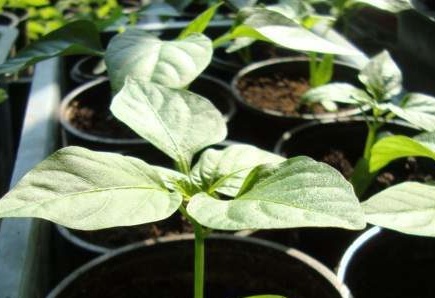
You can independently make containers for seedlings from improvised materials. Summer residents are advised to use liter packages of milk and kefir (tetrapack). They are cut off by 1/3, washed well and made several drainage holes below.
Into glasses
The main condition for the procedure is maximum accuracy, because when transplanting it is very easy to damage the roots. A few hours before the procedure seedlings are well watered, which reduces the risk of damage to the root system when removing plants from a common box. Diving into glasses is carried out as follows:
- Cups are filled with soil mixture and compacted well. Using a pencil in the middle of the glass, make a deep hole and pour it with warm water.
- With a small spatula or a tablespoon, one sprout is carefully removed from the box.
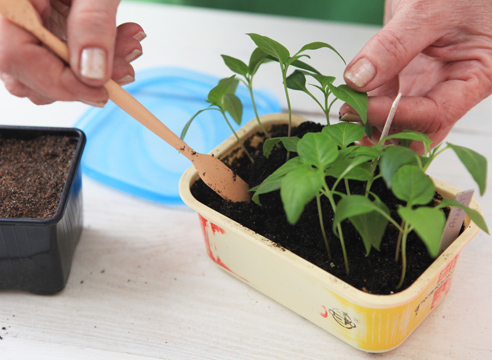
Sprout extraction - The seedling is buried so that the roots are freely located. To do this, pepper is first placed in the soil a little deeper than necessary, sprinkled with soil, and then slightly pulled up. Such manipulation will allow the roots to take the correct position underground.
- The soil around the plant is compacted so that the seedling stands firmly in a glass.
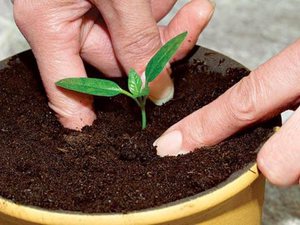
Soil compaction - The transplanted culture is slightly watered with water at room temperature.
Peaked peppers are best grown in the same place where they lived before the transplant. Changing conditions can slow the growth of seedlings, because she will need some time to adapt.
In the diaper
Experienced growers are advised to grow seedlings in "diapers", because this method will save not only space, but also capacity. As a diaper, a plastic bag is most often used. If the peppers grow in the cochlea, then it is pre-watered, and then carefully deployed on a flat surface. When growing the culture in boxes, it is also watered and carefully removed by 1 sprout. The process of transplanting into diapers includes such manipulations:
- a plastic bag is leveled and poured onto the surface of a little moistened soil (about 3 tablespoons);
- the extracted seedling is placed on a diaper so that the lower leaves are above its edge;
- sprinkle the root system with one spoon of earth;
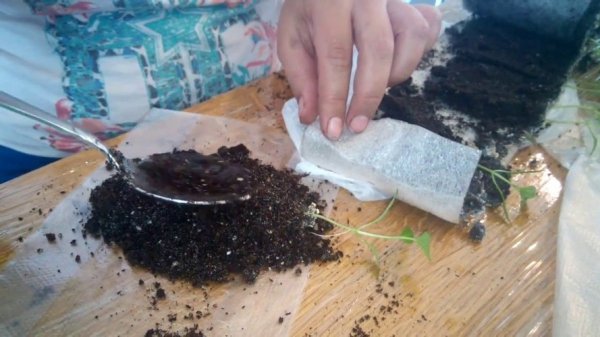
Powder root system - carefully wrap the film, and bend the bottom edge so that the soil does not spill out. The result should be "rolls" that can be fixed with elastic bands. Seedlings are placed in containers without holes and transferred to a bright room.
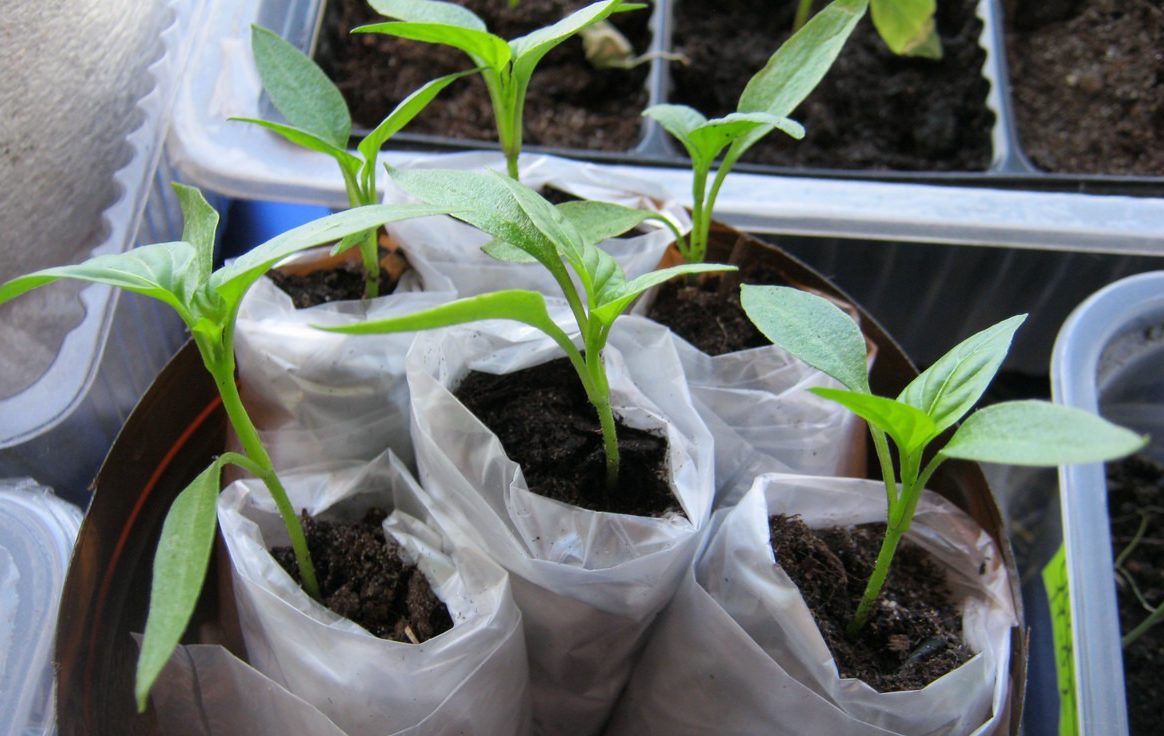
Seedlings in the film
The advantage of "swaddling" is the simplicity of subsequent planting in open ground. You just need to expand each roll and transplant stronger seedlings to a permanent place. Thanks to this method, the roots of the plant remain intact.
Dive Dates
Most summer residents are advised to dive seedlings at an early age, because then it will be much easier for her to take root in a new place. The optimal time for the procedure is considered to be the phase of 2-3 of these sheets. At this time, plants are about 15-20 days after germination of seedlings. Sometimes vegetable growers practice picking even in the cotyledon stage, and it happens that later in time - after the formation of 4-6 leaves.
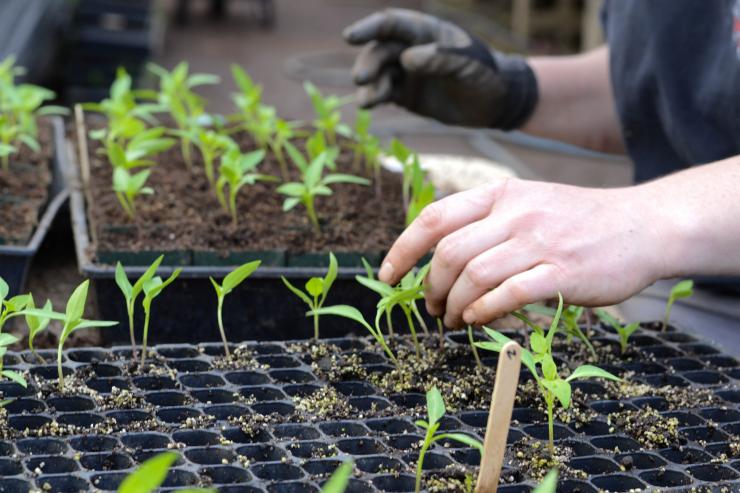
To minimize the risk of death of seedlings during transplantation, it is advised to familiarize yourself with the recommendations of the lunar calendar. Pick and planting of brittle peppers is carried out in the spring, for later varieties - even in June. In 2019, the most favorable days for work with seedlings will be:
- February: 5-9, 18-23, and on 14.15 and the 16th, you should not engage in planting work;
- March: 8-11, 13-15, 17-23, 26-29. Refrain from transplants should be 1-2, 10 and 30 March;
- in April it is better to dive in the first half of the month: 5-7, 9-11, 19.20, 23-25. Young seedlings are advised not to disturb April 15-17, 29 and 30;
- in May, transplants can be carried out on almost any day except the 15th and 29th;
- in June there are also a few unfavorable days: 12-14 and 26, and the most favorable ones are 4-6, 8-11, 19-23.
Transplanted plants at first require special attention, so a beginner should familiarize themselves with the rules for further care.
Dive care and top dressing
Immediately after the procedure, glasses with plants are transferred to a warm and bright place, protecting for several days from direct sunlight. If the seedlings will grow in the same place as before the transplant, then the adaptation will take place much faster than when moving to greenhouse conditions with a different microclimate.
Sprouts should be watered every 5-6 days. The first watering is carried out a week after transplantation. Watered with warm water in the morning, which helps to avoid the development of diseases. Before planting on beds, seedlings are fed twice: 10-14 days after diving and two weeks after the first feeding. Fertilizers must be in liquid form, and it must be applied only to moist soil (immediately after irrigation or at the same time). For the first time, you can feed the following solution:
- 10 g of ammonium nitrate;
- 30 g of potassium sulfate;
- 40 g of superphosphate;
- 10 liters of water.
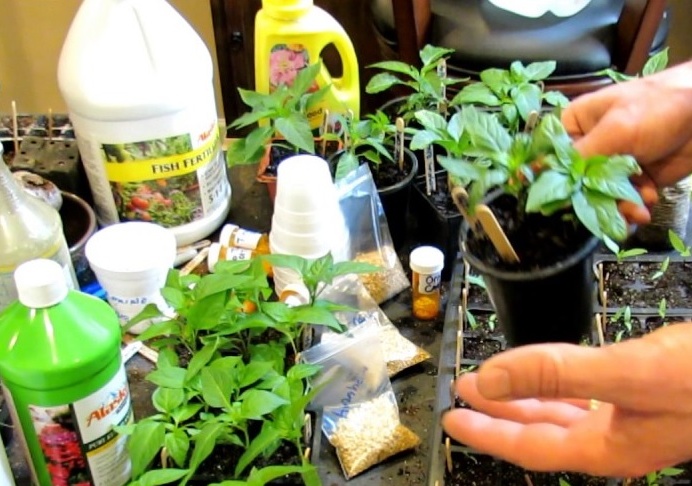
If necessary, you can feed young peppers with trace elements: about 1 g of zinc sulfate, 2 g of copper sulfate, 1 g of boric acid and up to 2 g of potassium permanganate are added to 10 l of water.
After a pick, you can begin to harden seedlings. Glasses begin to take to the street, gradually accustoming the culture to street conditions. The air temperature at this time should not be lower than 15 ° C. When placing seedlings on the street, it is important to exclude drafts and direct rays of the sun.
Possible mistakes when planting pepper
The most common mistake for beginners is the wrong time to dive. Vegetable growers believe that the procedure should be carried out already in the presence of 2-3 leaves, because the root system is just beginning to form and is easier to tolerate stress. Older plants, which have 4-6 leaves, have sufficiently developed roots, so it is very difficult not to damage them when planting.

The diameter of the pot (cup) should be within 8 cm. In addition, the container must necessarily have drainage holes.
Having become acquainted with the peculiarities of the culture, you can find out that pepper does not form additional roots, like tomatoes, so it is important not to allow a strong penetration of the stem into the soil. It is necessary to deepen the seedlings to the same level to which it was in the soil before the dive. If the root neck is deep in the ground, then, at best, the culture will stop growth, and at worst, it will become ill or even die.
Common mistakes include excessive watering and untimely fertilizer application. After the procedure, pepper is immediately watered, and the next watering is carried out not earlier than after 5-7 days. At first, the seedlings may look a little lethargic, but you should not immediately feed, after a dive at least 14 days should pass.
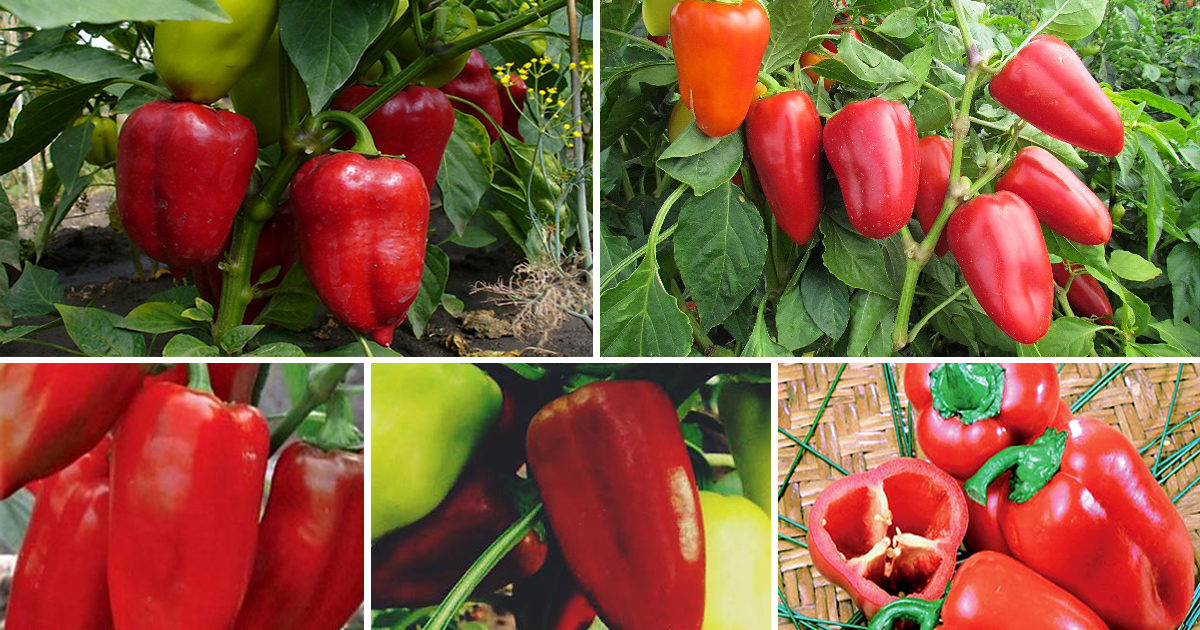 You may be interested in:
You may be interested in:Common questions
Growing bell peppers is a very exciting and interesting process. It is easy to grow a vegetable for seedlings, if all the recommendations of experienced gardeners are strictly followed. Particular attention should be paid to picking, because not only the future crop, but also the life of the plant depends on it.




 Calorie pepper stuffed with meat and rice - BZHU per 100 grams
Calorie pepper stuffed with meat and rice - BZHU per 100 grams Gorky pepper - the best varieties for open ground
Gorky pepper - the best varieties for open ground Hot pepper seeds - the best varieties for open ground and reviews
Hot pepper seeds - the best varieties for open ground and reviews Capsicum tincture for hair - how to use and reviews
Capsicum tincture for hair - how to use and reviews